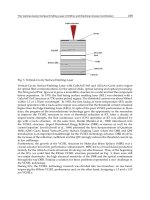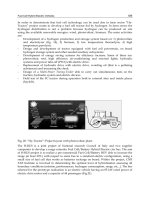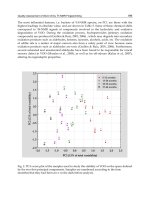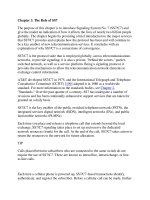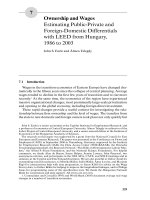Chapter 039. Nausea, Vomiting, and Indigestion (Part 7) potx
Bạn đang xem bản rút gọn của tài liệu. Xem và tải ngay bản đầy đủ của tài liệu tại đây (13.37 KB, 5 trang )
Chapter 039. Nausea, Vomiting,
and Indigestion
(Part 7)
Other Causes
Alkaline reflux esophagitis produces GERD-like symptoms in patients who
have had surgery for peptic ulcer disease. Opportunistic fungal or viral esophageal
infections may produce heartburn or chest discomfort but more often cause
odynophagia. Other causes of esophageal inflammation include eosinophilic
esophagitis and pill esophagitis. Biliary colic is in the differential diagnosis of
dyspepsia, but most patients with true biliary colic report discrete episodes of right
upper quadrant or epigastric pain rather than chronic burning discomfort, nausea,
and bloating. Intestinal lactase deficiency produces gas, bloating, discomfort, and
diarrhea after lactose ingestion. Lactase deficiency occurs in 15–25% of
Caucasians of northern European descent but is more common in African
Americans and Asians. Intolerance of other carbohydrates (e.g., fructose, sorbitol)
produces similar symptoms. Small-intestinal bacterial overgrowth may produce
dyspepsia, often with bowel dysfunction, distention, and malabsorption. Pancreatic
disease (chronic pancreatitis and malignancy), hepatocellular carcinoma, celiac
disease, Ménétrier's disease, infiltrative diseases (sarcoidosis and eosinophilic
gastroenteritis), mesenteric ischemia, thyroid and parathyroid disease, and
abdominal wall strain cause dyspepsia. Extraperitoneal etiologies of indigestion
include congestive heart failure and tuberculosis.
Approach to the Patient: Indigestion
History and Physical Examination
Care of the patient with indigestion requires a thorough interview. GERD
classically produces heartburn, a substernal warmth in the epigastrium that moves
toward the neck. Heartburn often is exacerbated by meals and may awaken the
patient. Associated symptoms include regurgitation of acid and water brash, the
reflex release of salty salivary secretions into the mouth. Atypical symptoms
include pharyngitis, asthma, cough, bronchitis, hoarseness, and chest pain that
mimics angina. Some patients with acid reflux on esophageal pH testing do not
report heartburn and note abdominal pain or other symptoms.
Some individuals with dyspepsia report a predominance of epigastric pain
or burning that is intermittent and not generalized or localized to other regions.
Others experience a postprandial distress syndrome characterized by fullness
occurring after normal-sized meals and early satiety that prevents completion of
regular meals several times weekly, with associated bloating, belching, or nausea.
Functional dyspepsia overlaps with other functional bowel disorders such as
irritable bowel syndrome.
The physical exam with GERD and functional dyspepsia usually is normal.
In atypical GERD, pharyngeal erythema and wheezing may be noted. Poor
dentition may be seen with prolonged acid regurgitation. Functional dyspeptics
may exhibit epigastric tenderness or abdominal distention.
Discrimination between functional and organic causes of indigestion
mandates exclusion of selected historic and examination features. Odynophagia
suggests esophageal infection, while dysphagia is worrisome for a benign or
malignant esophageal blockage. Other alarming features include unexplained
weight loss, recurrent vomiting, occult or gross gastrointestinal bleeding, jaundice,
a palpable mass or adenopathy, and a family history of gastrointestinal
malignancy.
Diagnostic Testing
As indigestion is prevalent and because most cases result from GERD or
functional dyspepsia, a general principle is to perform only limited and directed
diagnostic testing of selected individuals.
Once alarm factors are excluded (Table 39-3), patients with typical GERD
do not need further evaluation and are treated empirically. Upper endoscopy is
indicated to exclude mucosal injury in cases with atypical symptoms, symptoms
unresponsive to acid suppressing drugs, or alarm factors. For heartburn >5 years in
duration, especially in patients >50 years old, endoscopy is recommended to
screen for Barrett's metaplasia. However, the clinical benefits and cost-
effectiveness of this approach have not been validated in controlled studies.
Ambulatory esophageal pH testing using a catheter method or an implanted
esophageal capsule device is considered for drug-refractory symptoms and
atypical symptoms like unexplained chest pain. Esophageal manometry most
commonly is ordered when surgical treatment of GERD is considered. A low LES
pressure may predict failure of drug therapy and helps select patients who may
require surgery. Demonstration of disordered esophageal body peristalsis may
affect the decision to operate or modify the type of operation chosen. Manometry
with provocative testing may clarify the diagnosis in patients with atypical
symptoms. Blind perfusion of saline and then acid into the esophagus, known as
the Bernstein test, can delineate whether unexplained chest discomfort results
from acid reflux.
